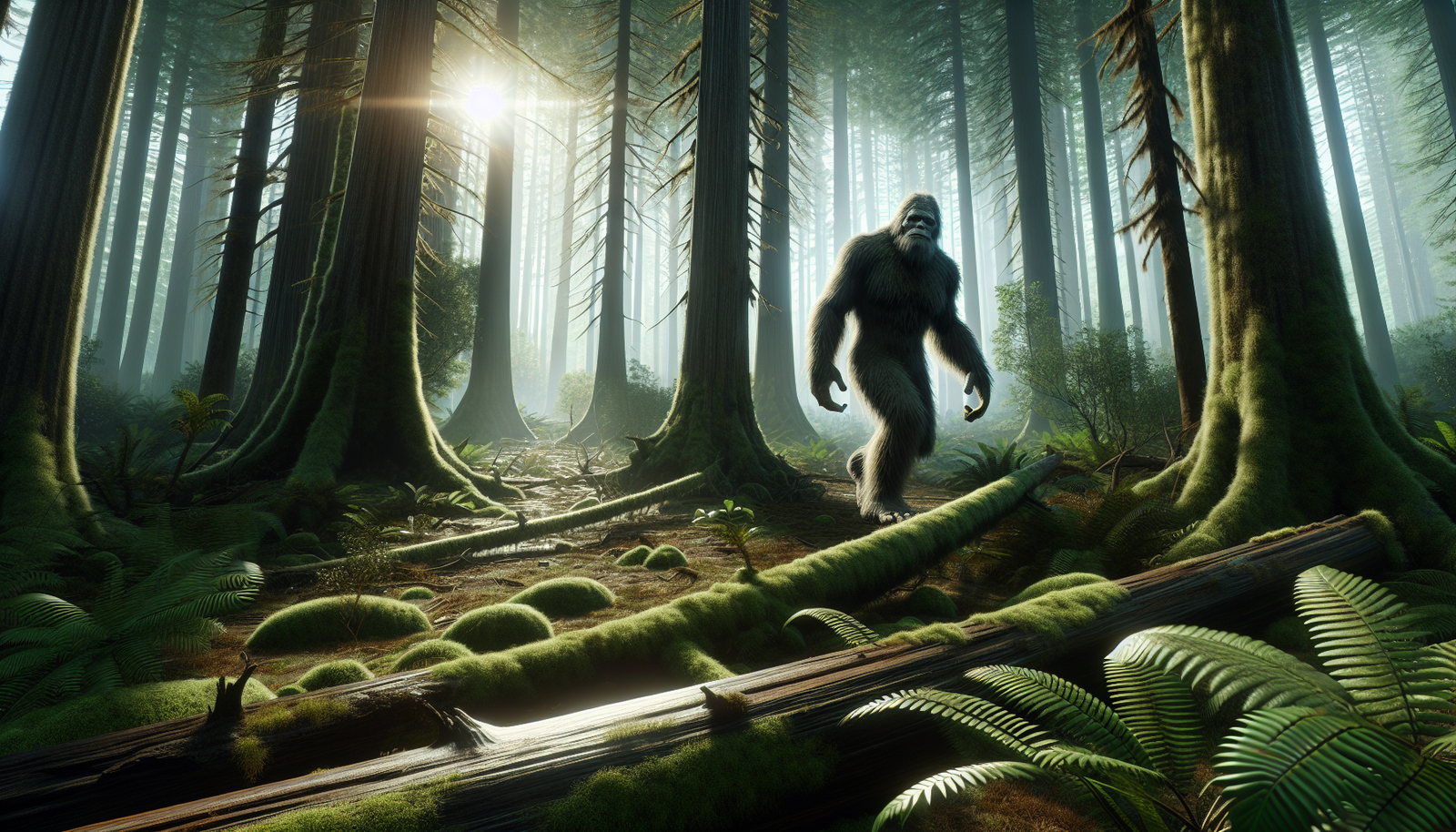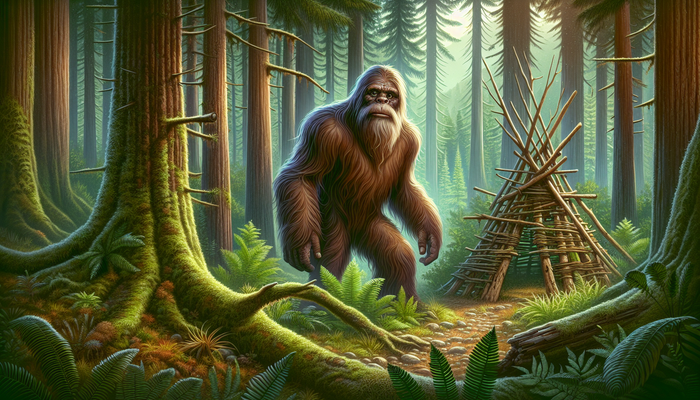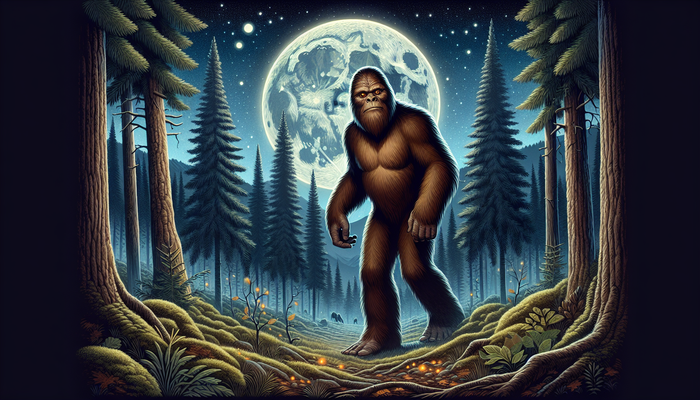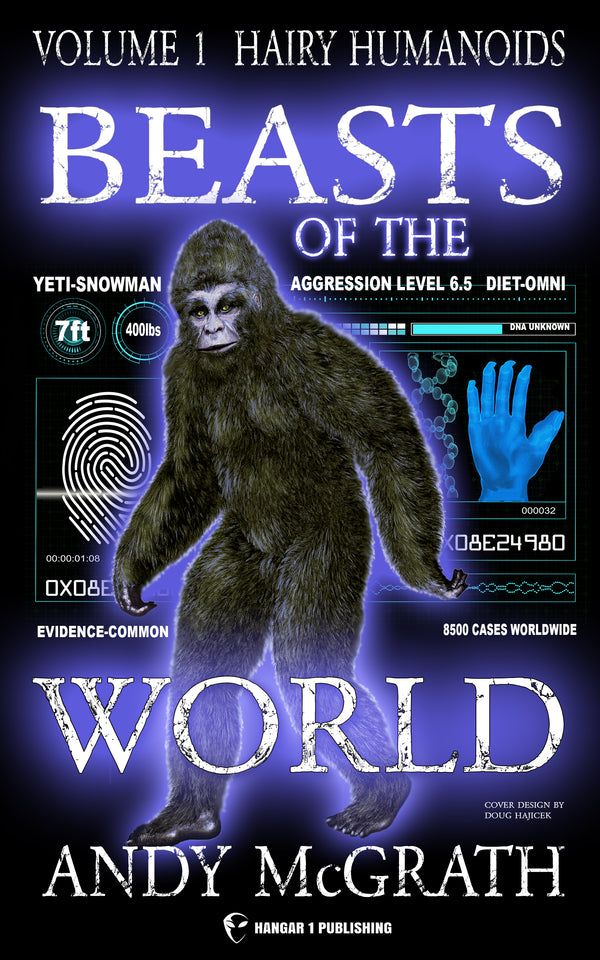Georgia Bigfoot: A Comprehensive Look at Sasquatch Sightings in the Peach State

By Oliver Bennett, Cryptozoologist
In the realm of cryptozoology, few creatures have captured the imagination quite like Bigfoot. This elusive, ape-like being, also known as Sasquatch, has been the subject of countless stories, sightings, and debates for decades. While reports of Bigfoot encounters span the globe, one state in particular has emerged as a hotspot for Sasquatch activity: Georgia. The Peach State boasts a rich history of Bigfoot sightings, from the rugged mountains of the north to the dense swamps of the south. As a researcher and scholar with a deep fascination for the unexplained, I have long been intrigued by the mysteries surrounding Georgia's Bigfoot phenomenon.
In this article, I will embark on a comprehensive exploration of the most compelling evidence and eyewitness accounts of Bigfoot in Georgia. Through meticulous research and analysis, I aim to shed light on the enduring legend of the Sasquatch and its place in the state's folklore and history. Join me as we delve into the heart of Georgia's Bigfoot country, examining the stories, the science, and the ongoing search for this enigmatic creature.
The Expedition: Bigfoot Museum - A Mecca for Sasquatch Enthusiasts
Nestled in the small town of Cherry Log, Georgia, lies a unique destination that has become a pilgrimage site for Bigfoot enthusiasts from around the world. The Expedition: Bigfoot museum, founded by David Bakara, is a 4,000-square-foot facility dedicated to the study and exploration of the Sasquatch phenomenon. Bakara, a lifelong Bigfoot researcher and certified investigator with the Bigfoot Field Researchers Organization (BFRO), opened the museum in 2016 as a way to share his passion and knowledge with the public.
Bakara's fascination with Bigfoot began at a young age, sparked by the 1972 film "The Legend of Boggy Creek." This early exposure to the world of cryptozoology set him on a path of discovery that would eventually lead him to the mountains of North Georgia. After years of conducting field investigations and collecting evidence, Bakara decided to create a space where visitors could immerse themselves in the mystery of Bigfoot.
The Expedition: Bigfoot museum is home to an extensive collection of artifacts and exhibits related to the Sasquatch. Visitors can examine casts of massive footprints, pore over hair samples, and even view a "Bigfoot butt print" - a unique piece of evidence that has garnered significant attention from researchers. The museum also features artistic renderings of the creature, newspaper clippings chronicling sightings, and a wealth of eyewitness accounts from those who claim to have encountered Bigfoot in the wild.
One of the most striking aspects of the museum is its interactive displays and immersive experiences. Visitors can listen to recordings of alleged Bigfoot vocalizations through provided headphones, allowing them to hear the eerie howls and grunts that have been reported by witnesses. The museum also features a replica of a Bigfoot nest, giving visitors a glimpse into the potential living habits of these elusive creatures.
Beyond its role as a public attraction, the Expedition: Bigfoot museum serves as an active research and reporting center. Bakara and his team work tirelessly to document new sightings and encounters, collaborating with visitors and the local community to gather evidence and expand their understanding of the Sasquatch phenomenon. Bakara's own personal Bigfoot sighting in Florida, where he observed two large, hairy creatures through a thermal imager, has only fueled his dedication to the cause.
As a researcher, I find the Expedition: Bigfoot museum to be a fascinating case study in the intersection of science, folklore, and public engagement. By providing a space for enthusiasts and skeptics alike to explore the evidence and form their own conclusions, Bakara has created a unique platform for the advancement of Bigfoot research. The museum's commitment to documenting and investigating sightings, coupled with its extensive collection of artifacts, makes it a valuable resource for anyone seeking to unravel the mysteries of the Sasquatch.
The Legendary Lumpkin County Dash Cam Footage
In the annals of Georgia Bigfoot history, few pieces of evidence have garnered as much attention and debate as the Lumpkin County dash cam footage. This remarkable video, captured by a sheriff's deputy in 2009, has become a touchstone for Bigfoot researchers and enthusiasts, offering a tantalizing glimpse into the possibility of Sasquatch's existence in the state.
The story behind the footage is as intriguing as the video itself. Late one night, a Lumpkin County sheriff's deputy was patrolling a rural road in the north Georgia mountains when his dash cam captured something extraordinary. In the video, a large, dark figure can be seen crossing the road with remarkable speed and agility, moving from one side of the forest to the other in just a few strides. The deputy, startled by the encounter, immediately reported the sighting to his superiors.
As news of the footage spread, Bigfoot researchers and enthusiasts from around the world began to analyze and debate its contents. Many experts praised the video for its clarity and the creature's size and movement, arguing that it provided compelling evidence for the existence of Sasquatch in Georgia. They pointed to the figure's bipedal gait, its apparent height and mass, and the speed with which it traversed the road as indicators that this was no ordinary animal.
However, the Lumpkin County footage has also been met with skepticism from some quarters. Critics have suggested that the figure could be a person in a costume, a misidentified bear, or even a hoax perpetrated by the deputy himself. They argue that the low-light conditions and the brevity of the encounter make it difficult to draw definitive conclusions about the nature of the creature.
Despite the ongoing debate, the Lumpkin County dash cam footage remains a landmark piece of evidence in the world of Bigfoot research. Its impact on the community cannot be overstated, as it has inspired countless investigations, theories, and discussions about the possibility of Sasquatch's presence in Georgia. For many researchers, myself included, the footage serves as a tantalizing clue in the larger puzzle of the Bigfoot mystery, one that demands further study and analysis.
As a scholar of cryptozoology, I have spent countless hours examining the Lumpkin County footage, frame by frame, in an effort to unravel its secrets. While I cannot claim to have definitive answers, I believe that the video represents a significant piece of evidence that cannot be easily dismissed. The creature's movements, size, and behavior are consistent with many other Bigfoot sightings reported throughout Georgia and beyond, suggesting that there may be more to this legend than meets the eye.
Of course, the Lumpkin County footage is just one piece of the larger Bigfoot puzzle in Georgia. To truly understand the scope and significance of the Sasquatch phenomenon in the state, we must delve deeper into the eyewitness accounts and physical evidence that have emerged over the years. From the mountains to the swamps, Georgia has proven to be a rich tapestry of Bigfoot lore, one that demands our attention and investigation.
The Minnehaha Falls Encounter
Among the many eyewitness accounts of Bigfoot in Georgia, few are as compelling or well-documented as the Minnehaha Falls encounter. This incident, which took place in the early 2000s, involved an off-duty police officer who claimed to have had a face-to-face encounter with a massive, hairy creature while visiting the picturesque waterfall alone at dusk.
According to the officer's account, he had just finished eating a sandwich and was preparing to leave the area when he noticed a figure standing at the base of the waterfall, staring directly at him. Curious, the officer approached the figure, assuming it was another hiker or visitor to the falls. As he drew closer, however, he realized that this was no ordinary human being.
The creature, which the officer estimated to be between 9 and 10 feet tall, was covered in dark, shaggy hair and had an imposing, muscular build. As the officer watched in amazement, the creature stood up to its full height, towering over him like a giant. The officer also noted a strong, unpleasant odor emanating from the creature, which he described as a combination of body odor and fecal matter.
Startled and frightened by the encounter, the officer drew his weapon and yelled at the creature, hoping to scare it off. To his surprise, the Bigfoot-like being turned and quickly retreated up the hillside, disappearing into the dense forest above the falls. The officer, shaken by the experience, immediately reported the sighting to his superiors and the local Bigfoot research community.
What sets the Minnehaha Falls encounter apart from many other Bigfoot sightings is the credibility of the witness. As a trained law enforcement officer, the individual who reported the encounter was well-versed in accurate observation and reporting, lending significant weight to his account. His description of the creature's size, appearance, and behavior also aligns closely with other Bigfoot sightings reported throughout Georgia and beyond.
As a researcher, I find the Minnehaha Falls encounter to be a fascinating case study in the importance of eyewitness testimony in the field of cryptozoology. While skeptics may argue that the officer's account could be the result of misidentification or even fabrication, the consistency and detail of his report suggest that there may be more to this story than meets the eye.
One of the most intriguing aspects of the Minnehaha Falls encounter is the creature's reported odor. Many Bigfoot witnesses have described a strong, unpleasant smell associated with their sightings, often likening it to a combination of wet dog, rotten meat, and feces. While the presence of an odor alone does not prove the existence of Sasquatch, it does add an additional layer of detail to the officer's account, one that is consistent with other reports from around the world.
Of course, as with any eyewitness account, the Minnehaha Falls encounter must be approached with a degree of caution and skepticism. Without physical evidence or additional witnesses to corroborate the officer's story, it is impossible to say with certainty that he encountered a genuine Bigfoot. However, the consistency of his report with other sightings, coupled with his credibility as a trained observer, makes this incident a compelling addition to the larger body of Bigfoot evidence in Georgia.
As we continue to explore the mysteries of the Sasquatch in the Peach State, encounters like the one at Minnehaha Falls serve as important reminders of the power of eyewitness testimony. While physical evidence may be the holy grail of Bigfoot research, the stories and experiences of those who claim to have seen these creatures firsthand cannot be discounted. They provide valuable insights into the behavior, appearance, and habitat of these elusive beings, and they help to shape our understanding of the Bigfoot phenomenon as a whole.
The Elkins Creek Footprint Cast
In the world of Bigfoot research, physical evidence is often the most sought-after and debated aspect of the phenomenon. While eyewitness accounts and sightings provide compelling anecdotal evidence for the existence of Sasquatch, it is the tangible, measurable clues left behind by these creatures that hold the greatest potential for scientific analysis and verification. In Georgia, one of the most significant pieces of physical evidence related to Bigfoot is the Elkins Creek footprint cast, discovered in 1997 near the town of Meansville.
The story of the Elkins Creek cast begins with Deputy James P. Akin, a local law enforcement officer who was patrolling the area when he stumbled upon a series of massive footprints in the mud. Recognizing the potential significance of his find, Akin carefully documented the prints, taking detailed measurements and photographs of the impressions. He even went so far as to create a plaster cast of one of the prints, which measured an astonishing 17.5 inches long and 8.5 inches wide.
Akin's discovery quickly attracted the attention of the Bigfoot research community, who were eager to examine the cast and assess its potential as evidence of Sasquatch's presence in Georgia. The cast was sent to several experts for analysis, including Dr. Grover Krantz, a renowned anthropologist and Bigfoot researcher, and Jimmy Chilcutt, a latent fingerprint examiner with the Conroe, Texas Police Department.
Upon examining the Elkins Creek cast, both Krantz and Chilcutt came to a remarkable conclusion. They found that the cast displayed clear dermal ridges and other anatomical features that were consistent with a non-human primate, rather than a human foot. Chilcutt, in particular, was emphatic in his assessment, stating that the cast "was definitely the ridges of a non-human primate." This analysis, combined with the sheer size of the print, lent significant credibility to the idea that the Elkins Creek footprints were left by a genuine Bigfoot creature.
The Elkins Creek cast has since become a centerpiece of the Expedition: Bigfoot museum's collection, serving as a tangible piece of evidence that visitors can examine and ponder. Its inclusion in the museum, along with the detailed accounts of its discovery and analysis, helps to solidify Georgia's reputation as a hotbed of Bigfoot activity and a prime location for future research and exploration.
As a researcher, I have had the opportunity to examine the Elkins Creek cast firsthand, and I must say that it is a truly remarkable piece of evidence. The level of detail captured in the cast, from the clear impression of the toes to the texture of the skin, is unlike anything I have seen in other alleged Bigfoot prints. While I maintain a healthy skepticism about the origins of the cast, I cannot deny that it represents a compelling piece of the larger Bigfoot puzzle.
One of the most intriguing aspects of the Elkins Creek cast is its potential to provide insights into the anatomy and behavior of these elusive creatures. By studying the size, shape, and distribution of the dermal ridges, researchers can begin to make inferences about the evolutionary history and adaptations of Sasquatch. For example, the presence of dermal ridges on the bottom of the foot suggests that Bigfoot may have evolved to walk upright on two legs, much like humans.
Of course, as with any piece of physical evidence related to Bigfoot, the Elkins Creek cast is not without its detractors. Some skeptics have suggested that the print could have been hoaxed, either by Deputy Akin himself or by someone else seeking to perpetrate a Bigfoot-related prank. Others have argued that the cast could be the result of a misidentified animal print, such as that of a bear or other large mammal.
While these alternative explanations cannot be entirely dismissed, the expert analysis and detailed documentation surrounding the Elkins Creek cast make it a compelling piece of evidence in the larger Bigfoot debate. As researchers continue to study the cast and compare it to other alleged Bigfoot prints from around the world, it is likely that new insights and theories will emerge about the nature and origins of these mysterious creatures.
Ultimately, the Elkins Creek footprint cast serves as a powerful reminder of the importance of physical evidence in the field of cryptozoology. While eyewitness accounts and sightings may provide the initial spark of interest in a particular phenomenon, it is the tangible, measurable clues left behind by these creatures that hold the greatest potential for scientific analysis and verification. As we continue to explore the mysteries of Bigfoot in Georgia and beyond, the Elkins Creek cast will undoubtedly remain a key piece of the puzzle, one that demands our attention and investigation.
From Bigfoot to UFOs: Hangar 1 Publishing Has You Covered!
Explore Untold Stories: Venture into the world of UFOs, cryptids, Bigfoot, and beyond. Every story is a journey into the extraordinary.
Immersive Book Technology: Experience real videos, sights, and sounds within our books. Its not just reading; its an adventure.



























